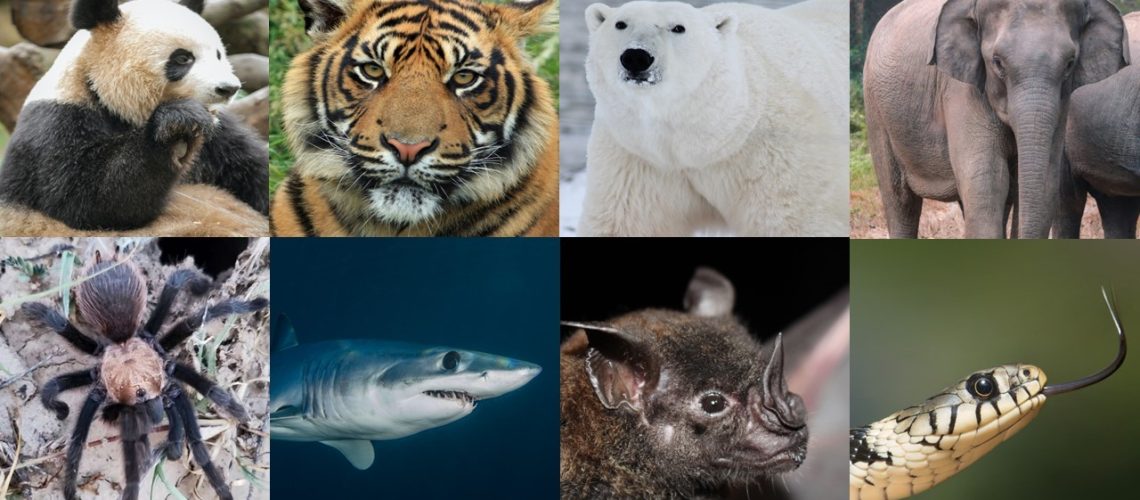Guest Post by Jackie Billotte, 2022-2023 Sustainability Leadership Fellow, and Ph.D. Candidate in the Department of Agricultural Biology at Colorado State University
Up to 1 million species may be at risk of extinction, according to a recent United Nations report on biodiversity1. Currently, the United States spends approximately $300 million annually on conservation. Hundreds of endangered animal and plant species receive as little as $1,000 a year for their species recovery 2. The competition to receive conservation funding can be fierce. The use of charismatic species for conservation funding is widespread. The cute cuddly face of a polar bear or lion cub can tug at anyone’s heartstrings. But having an adorable, fuzzy face should not be the only qualifier for a species to receive conservation protections or the attention of researchers. When people find an animal more appealing, they are more likely to donate money for conservation or support conservation initiatives 5. This method, however, allows humans to pick winners and losers in nature. Left behind are those species deemed “non-charismatic fauna.” Among them are bats, snakes, spiders, worms, and mollusks. Basically, the animals that humans find disinteresting, frightening, or disgusting.
When certain species are prioritized because of their popularity, it may also create a feedback loop in which people are exposed to the risks faced by these charismatic species, such as melting sea ice or wildfires, thereby associating these species with the need for conservation and increasing the funding directed toward these species 4–6. Because the research is already funded, the public learns more about the problems facing these species, leaving behind less popular critters, which may also be facing the same environmental problems.
Effects of a Lack of Research
Like many things, the more you know about a situation, the easier it is to manage the situation. This is true in conservation as well. Research allows us to assess if a species is at risk, and the degree and source of that risk7. Increased conservation research also helps to identify what actions can be taken to protect the species 8.
One way some have tried to compensate for the lack of research on non-charismatic species is to use “umbrella species”, which are charismatic species whose conservation is thought to also protect species that share its habitat 9. The umbrella species concept uses charismatic animals whose conservation can attract large amounts of support and funding to provide a protective “umbrella” to the animals that live around them 9. Though this has proven more successful in the concept than in practice, as multiple factors influence the outcome of using umbrella species. For example, conservation efforts for the sage grouse in the western United States have been shown to protect many species that live alongside them. However, not all species benefitted equally, including the black-footed ferret, a species whose continued survival has relied on small, heavily managed populations 11. Another example of the umbrella species concept falling short is the giant panda. One of the most iconic umbrella species and one of the ten most charismatic species, whose need for protection is well known12 were still unable to provide adequate protection for other endangered species 13.
What can be Done
So, what can we do to help shine a spotlight on the non-charismatic fauna? Well, a simple solution is to make them charismatic. The fear of many species is thought to mainly arise from cultural reinforcement, rather than from hard-wired instinct 14. And this means it is possible to effectively change how people view an animal 15,16.
Over the past few years, there has been increased interest in trying to understand why people believe what they do, and how we can effectively communicate a message aimed at changing someone’s opinion 17–20. The reasons behind a person’s actions and views are complex. One thing has become clear though: facts do not change a person’s mind 21. If you throw facts at a person, it usually won’t have any effect on their current views on a topic (or in this case species). Worse, this communication strategy could end up driving a person deeper into their corner 22.

Rather, experience-based outreach is effective at allowing people to develop new, positive associations with non-charismatic fauna 15,23. Giving people the opportunity to build positive experiences with animals can help the person to build a familiarity with that animal and even begin to care about what happens to the animal 24,25. Experiences that allow the person to personally interact with an animal and that anthropomorphize an animal could be the best way to turn non-charismatic fauna into charismatic fauna and increase public interest in their conservation and research 26,27. Few people would consider sharks accessible and friendly, but after participating in a zoo encounter (from the safety of a cage) visitors to the São Paulo Zoo reported more positive views of the animals 28.
As humans, we like to think we are special, and somewhere along the way we got to decide which parts of nature we liked, and which we did not. If a species is being threatened by human activity, it seems odd that we should also get to choose if that species deserves saving from us. While it may be tempting to focus our conservation on animals, we find adorable, remember the scaley, spikey, slimy creatures all serving valuable roles in their ecosystems, all worthy of saving.
REFERENCES
- Intergovernmental Science-Policy Platform on Biodiversity and Ecosystem Services, I. Methodological assessment of the diverse values and valuation of nature of the Intergovernmental Science-Policy Platform on Biodiversity and Ecosystem Services. (2022) doi:10.5281/ZENODO.6522523.
- Kurose, S. & Hammer, H. Congress Urged to Increase Spending to $700 Million for Endangered Species Conservation – Center for Biological Diversity. Center for Biological Diversity https://biologicaldiversity.org/w/news/press-releases/congress-urged-to-increase-spending-to-700-million-for-endangered-species-conservation-2022-03-10/ (2022).
- Albert, C., Luque, G. M. & Courchamp, F. The twenty most charismatic species. PLoS One 13, (2018).
- Lorimer, J. Nonhuman charisma. Environ Plan D 25, 911–932 (2007).
- Krause, M. & Robinson, K. Charismatic Species and Beyond: How Cultural Schemas and Organisational Routines shape Conservation. Conservation and Society 15, 313–321 (2017).
- Doi, H. & Takahara, T. Global patterns of conservation research importance in different countries of the world. doi:10.7717/peerj.2173.
- Laurance, W. F. et al. Making conservation research more relevant for conservation practitioners. Biological Conservation vol. 153 164–168 Preprint at https://doi.org/10.1016/j.biocon.2012.05.012 (2012).
- Drury, R., Homewood, K. & Randall, S. Less is more: The potential of qualitative approaches in conservation research. Animal Conservation vol. 14 18–24 Preprint at https://doi.org/10.1111/j.1469-1795.2010.00375.x (2011).
- Roberge, J. M. & Angelstam, P. Usefulness of the Umbrella Species Concept as a Conservation Tool. Conservation Biology 18, 76–85 (2004).
- Branton, M. & Richardson, J. S. Assessing the Value of the Umbrella-Species Concept for Conservation Planning with Meta-Analysis. Conservation Biology 25, 9–20 (2011).
- Runge, C. A. et al. Single species conservation as an umbrella for management of landscape threats. PLoS One 14, (2019).
- Courchamp, F. et al. The paradoxical extinction of the most charismatic animals. PLoS Biol 16, (2018).
- Wang, F. et al. The hidden risk of using umbrella species as conservation surrogates: A spatio-temporal approach. Biol Conserv 253, (2021).
- Smith-Janik, S. B. & Teachman, B. A. Impact of priming on explicit memory in spider fear. Cognit Ther Res 32, 291–302 (2008).
- Meadows, A. WILDLIFE CONSERVATION EDUCATION AND INTERNATIONAL PROGRAMMES Wildlife Conservation Education Programmes : It is Conservation Education and Outreach Techniques : 21, 305–316 (2011).
- Zimmer, A. et al. Effectiveness of a smartphone-based, augmented reality exposure app to reduce fear of spiders in real-life: A randomized controlled trial. J Anxiety Disord 82, (2021).
- Newman, T. P., Nisbet, E. C. & Nisbet, M. C. Climate change, cultural cognition, and media effects: Worldviews drive news selectivity, biased processing, and polarized attitudes. Public Understanding of Science 27, 985–1002 (2018).
- Manfredo, M. J. et al. Why social values cannot be changed for the sake of conservation. Conservation Biology 31, 772–780 (2017).
- Manfredo, M. J., Teel, T. L., Sullivan, L. & Dietsch, A. M. Values, trust, and cultural backlash in conservation governance: The case of wildlife management in the United States. Biol Conserv 214, 303–311 (2017).
- Dietsch, A. M., Manfredo, M. J., Leeann, S., Bruskotter, J. T. & Teel, T. L. A Multilevel, System View of Values Can Inform a Move towards Human-Wildlife Coexistence. in Human-Wildlife Interactions: Turning Conflict into Coexsistence (eds. Frank, B., Glikman, J. A. & Marchini, S.) 21–44 (Cambridge University Press, 2019).
- Hornsey, M. J. Why Facts Are Not Enough: Understanding and Managing the Motivated Rejection of Science. Curr Dir Psychol Sci 29, 583–591 (2020).
- Manfredo, M. J., Berl, R. E. W., Teel, T. L. & Bruskotter, J. T. Bringing social values to wildlife conservation decisions. Front Ecol Environ 19, 355–362 (2021).
- Pearce‐Kelly, P., Clarke, D., Robertson, M. & Andrews, C. The display, culture and conservation of invertebrates at London Zoo. International Zoo Yearbook 30, 21–30 (1991).
- Ardoin, N. M., Bowers, A. W. & Gaillard, E. Environmental education outcomes for conservation: A systematic review. Biological Conservation vol. 241 Preprint at https://doi.org/10.1016/j.biocon.2019.108224 (2020).
- Frantz, C. M. P. & Mayer, F. S. The importance of connection to nature in assessing environmental education programs. Studies in Educational Evaluation 41, 85–89 (2014).
- Parsons, T. D. & Rizzo, A. A. Affective outcomes of virtual reality exposure therapy for anxiety and specific phobias: A meta-analysis. J Behav Ther Exp Psychiatry 39, 250–261 (2008).
- Webber, S., Carter, M., Smith, W. & Vetere, F. Interactive technology and human–animal encounters at the zoo. International Journal of Human Computer Studies vol. 98 150–168 Preprint at https://doi.org/10.1016/j.ijhcs.2016.05.003 (2017).
- de Oliveira Rancura, K. G. et al. How to evaluate environmental education actions at the zoo? The experience of São Paulo Zoo (Brazil). (2017).






